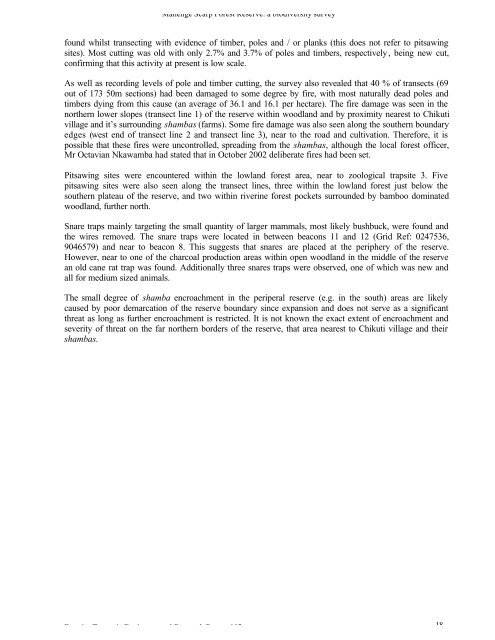Mahenge Scarp Forest Reserve - Frontier-publications.co.uk
Mahenge Scarp Forest Reserve - Frontier-publications.co.uk
Mahenge Scarp Forest Reserve - Frontier-publications.co.uk
Create successful ePaper yourself
Turn your PDF publications into a flip-book with our unique Google optimized e-Paper software.
<strong>Mahenge</strong> <strong>Scarp</strong> <strong>Forest</strong> <strong>Reserve</strong>: a biodiversity survey<br />
found whilst transecting with evidence of timber, poles and / or planks (this does not refer to pitsawing<br />
sites). Most cutting was old with only 2.7% and 3.7% of poles and timbers, respectively , being new cut,<br />
<strong>co</strong>nfirming that this activity at present is low scale.<br />
As well as re<strong>co</strong>rding levels of pole and timber cutting, the survey also revealed that 40 % of transects (69<br />
out of 173 50m sections) had been damaged to some degree by fire, with most naturally dead poles and<br />
timbers dying from this cause (an average of 36.1 and 16.1 per hectare). The fire damage was seen in the<br />
northern lower slopes (transect line 1) of the reserve within woodland and by proximity nearest to Chikuti<br />
village and it’s surrounding shambas (farms). Some fire damage was also seen along the southern boundary<br />
edges (west end of transect line 2 and transect line 3), near to the road and cultivation. Therefore, it is<br />
possible that these fires were un<strong>co</strong>ntrolled, spreading from the shambas, although the local forest officer,<br />
Mr Octavian Nkawamba had stated that in October 2002 deliberate fires had been set.<br />
Pitsawing sites were en<strong>co</strong>untered within the lowland forest area, near to zoological trapsite 3. Five<br />
pitsawing sites were also seen along the transect lines, three within the lowland forest just below the<br />
southern plateau of the reserve, and two within riverine forest pockets surrounded by bamboo dominated<br />
woodland, further north.<br />
Snare traps mainly targeting the small quantity of larger mammals, most likely bushbuck, were found and<br />
the wires removed. The snare traps were located in between bea<strong>co</strong>ns 11 and 12 (Grid Ref: 0247536,<br />
9046579) and near to bea<strong>co</strong>n 8. This suggests that snares are placed at the periphery of the reserve.<br />
However, near to one of the char<strong>co</strong>al production areas within open woodland in the middle of the reserve<br />
an old cane rat trap was found. Additionally three snares traps were observed, one of which was new and<br />
all for medium sized animals.<br />
The small degree of shamba encroachment in the periperal reserve (e.g. in the south) areas are likely<br />
caused by poor demarcation of the reserve boundary since expansion and does not serve as a significant<br />
threat as long as further encroachment is restricted. It is not known the exact extent of encroachment and<br />
severity of threat on the far northern borders of the reserve, that area nearest to Chikuti village and their<br />
shambas.<br />
<strong>Frontier</strong> Tanzania Environmental Research Report 107 18

















